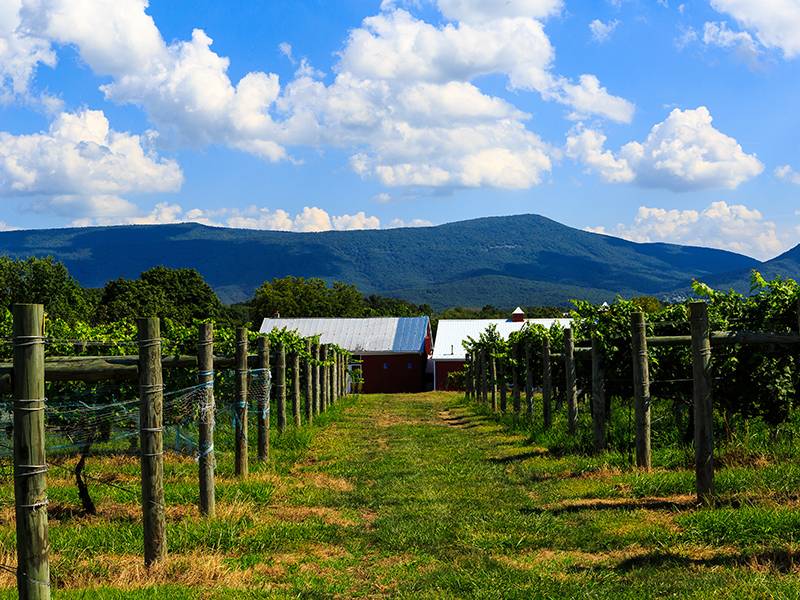October is Virginia Wine Month

The state of Virginia has almost 300 wineries and seven regions that have been designated as American Viticultural Areas. Starting in 1988, October was designated Virginia Wine Month. Here’s some info to help as you explore what Virginia wine has to offer.
History
The history of wine making in Virginia extends all the way back to the original settlers. England was interested in becoming less dependent on France for wine and the hope was that the new American colonies could become their new source. Men were required by law to plant grape vines for the purpose of making wine, or face punishment. Early attempts to grow European grape vines and make wine were largely unsuccessful, despite numerous incentives and grants from London. The first successful bottling of any significance didn’t happen until the 1760s.
During the late 1700s and early 1800s, Thomas Jefferson was an outspoken advocate for growing and making wine from vinifera vines in Virginia. In addition to trying to grow vines himself, he gave a portion of his property to Pillip Mazzei, and Italian viticulturist, for the purpose of growing grapes. While neither of them was successful in bottling wine, Jefferson’s encouragement and vision did propel others forward and he is largely credited with the resulting wine industry that currently exists in the state.
During the 1800s, the native Norton grape was discovered and became popular in the state for making wine. It was also during this time that a large amount of grape vines across Europe were being destroyed by a pest known as Phyloxera. Once it was discovered that American vines were immune to the pest, European wine makers began grafting their vines onto American rootstock. Without such a discovery and change in practice, the European wine industry would have been wiped out.
Many vines were destroyed and wineries were closed in Virginia during the time of Prohibition in the early 1900s. It took more than 30 years after the end of Prohibition for wineries to re-open in the state. In the 1970s, Italian winemaker Gianni Zonnin decided to expand into America and chose an area near Charlottesville as the site of his new winery. Zonin brought in Italian winemaker Gabriele Rausse to help get the new winery—now known as Barboursville Winery—going. Rausse has gone on to consult with a number of other winery startups over the years and created his own winery in 1997. Rausse is both literally and figuratively the “father of modern Virginia wine,” as his sons now make wine for the Gabriele Rausse winery and Muse Winery.
American Viticultural Areas
The wine industry has grown in both size and sophistication over the last 40 years. As part of this growth, seven American Viticultural Areas (AVA) have been established in Virginia. AVAs represent regions with distinct geography, soil and climate which affect the wine. For any wine bearing an AVA designation, 85% of the wine must come from grapes grown in that region. The current Virginia AVAs are:
- George Washington Birthplace AVA covering the northern neck of Virginia
- Middleburg AVA around the town of Middleburg, 50 miles west of Washington DC
- Monticello AVA located in the central Piedmont area around Charlottesville
- North Fork of Roanoke AVA on the eastern slopes of the Allegheny Mountains
- Rocky Knob AVA located in Floyd and Patrick Counties on the eastern slope of the Blue Ridge Mountains
- Shenandoah Valley AVA covering the area surrounded by the Blue Ridge, Allegheny and Appalachian mountains
- Virginia’s Eastern Shore AVA covering the Delmarva Peninsula
Grapes
Virginia wine makers grow a wide assortment of European vinifera grapes, native grapes, and hybrids of the two. Overall and among vinifera grapes, the top grapes are Cabernet Franc, Cabernet Sauvignon, Chardonnay, Merlot, Petite Verdot and Viognier (designated the official state grape in 2011). While all of the top vinifera grapes come from France, wine makers are starting to experiment with Spanish and Portuguese grapes as well, with some positive results. Be on the lookout for more Albarino and Touriga Nacional in the future.
Among the hybrid grapes (grapes that have one vinifera and one native parent), Chambourcin and Vidal Blanc are the most popular. Among the native grapes, it is no surprise that Norton is still the most planted.

Comments
Be the first to comment...